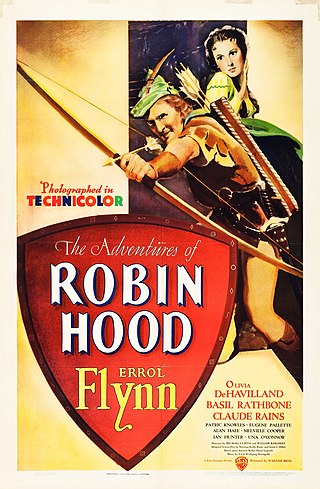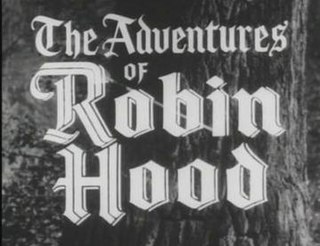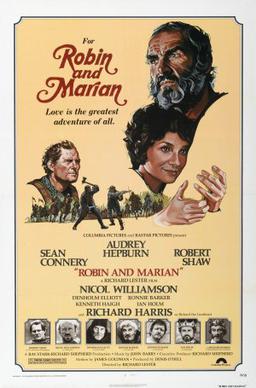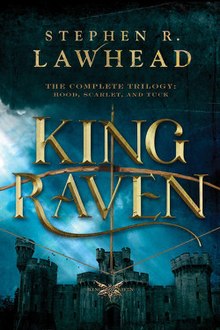Stephen R. Lawhead is an American writer known for his works of fantasy, science fiction, and historical fiction, particularly Celtic historical fiction. He has written over 28 novels and numerous children's and non-fiction books.

The Adventures of Robin Hood is a 1938 American Technicolor epic swashbuckler film from Warner Bros. Pictures. It was produced by Hal B. Wallis and Henry Blanke, directed by Michael Curtiz and William Keighley, and stars Errol Flynn, Olivia de Havilland, Basil Rathbone, Claude Rains, Patric Knowles, Eugene Pallette, and Alan Hale. The film is particularly noted for its Academy Award-winning score by Erich Wolfgang Korngold.

Brân the Blessed is a giant and king of Britain in Welsh mythology. He appears in several of the Welsh Triads, but his most significant role is in the Second Branch of the Mabinogi, Branwen ferch Llŷr. He is a son of Llŷr and Penarddun, and the brother of Brânwen, Manawydan, Nisien and Efnysien. The name "Brân" in Welsh is usually translated as crow or raven.

The Adventures of Robin Hood is a British television series comprising 143 half-hour, black and white episodes broadcast weekly between 1955 and 1959 on ITV. It starred Richard Greene as the outlaw Robin Hood, and Alan Wheatley as his nemesis, the Sheriff of Nottingham. The show followed the legendary character Robin Hood and his band of merry men in Sherwood Forest and the surrounding vicinity. While some episodes dramatised the traditional Robin Hood tales, most were original dramas created by the show's writers and producers.

Sir Guy of Gisbourne is a character from the Robin Hood legends of English folklore. He first appears in "Robin Hood and Guy of Gisborne", where he is an assassin who attempts to kill Robin Hood but is killed by him. In later depictions, he has become a romantic rival to Robin Hood for Maid Marian's love.

The Grey King is a contemporary fantasy novel by Susan Cooper, published almost simultaneously by Chatto & Windus and Atheneum in 1975. It is the fourth of five books in her Arthurian fantasy series The Dark is Rising.

Robin Hood is a 1922 silent adventure film starring Douglas Fairbanks and Wallace Beery. It was the first motion picture ever to have a Hollywood premiere, held at Grauman's Egyptian Theatre on October 18, 1922. The movie's full title, under which it was copyrighted, is Douglas Fairbanks in Robin Hood. It was one of the most expensive films of the 1920s, with a budget estimated at one million dollars. The film was a smash hit and generally received favorable reviews.

Conquests of the Longbow: The Legend of Robin Hood is a graphic adventure game designed by Christy Marx and published by Sierra On-Line in 1991. It is the second and final part of the Conquests series, which begins with Conquests of Camelot: The Search for the Grail. It features VGA graphics and Sierra's standard icon-driven interface first seen in King's Quest V.

Robin and Marian is a 1976 romantic adventure film from Columbia Pictures, shot in Panavision and Technicolor, that was directed by Richard Lester and written by James Goldman after the legend of Robin Hood. The film stars Sean Connery as Robin Hood, Audrey Hepburn as Lady Marian, Nicol Williamson as Little John, Robert Shaw as the Sheriff of Nottingham, Richard Harris as Richard the Lionheart, and Denholm Elliott as Will Scarlet. It also features comedian Ronnie Barker in a rare film role as Friar Tuck. Robin and Marian was filmed in Zamora, as well as Artajona, Urbasa, Quinto Real and Orgi, all small medieval villages in Navarre, Spain. It marked Hepburn's return to the screen after an eight-year absence.
Angharad is a feminine given name in the Welsh language, having a long association with Welsh royalty, history and myth. It translates into English as much loved one. In Welsh mythology, Angharad Golden-Hand is the lover of Peredur in the myth cycle The Mabinogion.

Robin Hood is a 1991 British adventure film directed by John Irvin, executive produced by John McTiernan, and starring Patrick Bergin, Uma Thurman, Jürgen Prochnow, Jeroen Krabbé, and Edward Fox. Although originally intended for a theatrical release in the United States and South America, the film instead premiered on television, on the Fox network in those territories a month before the release of Robin Hood: Prince of Thieves. It was released in cinemas in several countries in Europe and elsewhere, including Australia, New Zealand and Japan.

The folkloric hero Robin Hood has appeared many times, in many different variations, in popular modern works.
William II of England has been depicted in various cultural media.

Elfael was one of a number of Welsh cantrefi occupying the region between the River Wye and river Severn, known as Rhwng Gwy a Hafren, in the early Middle Ages. It was divided into two commotes, Is Mynydd and Uwch Mynydd, separated by the chain of hills above Aberedw. In the late medieval period, it was a marcher lordship. However, after the Laws in Wales Act 1535, it was one of the territorial units which went to make up the county of Radnorshire in 1536.

The Outlaws of Sherwood is a retelling of the legend of Robin Hood by Robin McKinley. In McKinley's afterword, she says, "The retellings through the centuries have echoed concurrent preoccupations." The story includes both the traditional Robin Hood characters — Little John, Much, Friar Tuck, Marian and Alan-a-dale — and characters of McKinley's own invention. Notably, three of the most important characters are women, all of whom escape marriage to prospective spouses chosen by their fathers.
Tamera Lynn Gattis Alexander is an American author of Christian fiction, who specializes in the inspirational romance genre. She is best known for her award-winning first series, the Fountain Creek Chronicles (2006–07).
Robin Hood is a comic opera by Reginald De Koven (music), Harry B. Smith (lyrics) and Clement Scott. The story is based on the Robin Hood legend, during the reign of King Richard I. The opera was composed in Chicago, Illinois during the winter of 1888-1889.

Lady of the Forest: A Novel of Sherwood is a 1992 historical fiction novel by American author Jennifer Roberson. A re-telling of the Robin Hood legend from the perspective of twelve characters associated with the legend, the story centers around English noblewoman Lady Marian FitzWalter's encounters with Lord Robert of Locksley and his scheming rival the Sheriff of Nottingham amid the backdrop of Prince John's schemes – he aims to increase his own wealth and power at the expense of post-Conquest England and his brother, King Richard.












